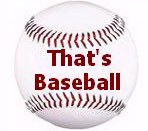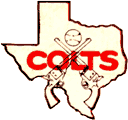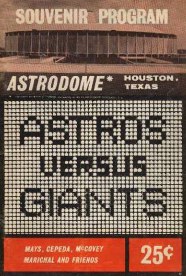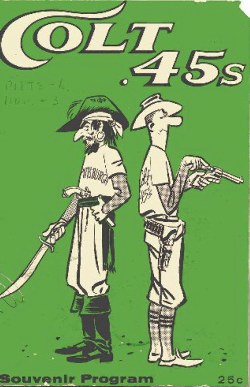 |
The
Houston Colt .45s/Astros
in the 1960s
|
 |
||||||||
 |
Paul Richard, the tall, gaunt Texas native, the "Wizard of Waxahachie" ... was hired by the Colt 45s in September of 1961, and given complete control of baseball operations .... As a field manager, Richards had sparked the transformation of the Chicago White Sox and Baltimore Orioles from doormats to contenders, but he saw the Houston opportunity as the culmination of his 35-year baseball career.
In the N.L. expansion draft, conducted on October 10, 1961, Richards selected 21 players. As measured by Win Shares, his draft would rival that of the Angels as the most effective among the original four expansion teams .... [T]he Colt 45s' expansion picks as a group would go on to compile a total of 550 WS, with a median of 15, by far the most of any team. The Colt 45s' draft would yield no stars to compare with the Angels' Jim Fregosi or Dean Chance, but it was a solid group ....
The most fruitful of Houston's picks was 23-year-old Bob Aspromonte, a slick-fielding infielder with minimal previous big league experience. He would step in as a productive regular third baseman for the next six years. The Colt 45s would also get excellent mileage from pitchers Dick Farrell and Ken Johnson.
Paul Richards was intelligent and intense, and had earned the reputation of an astute tactician as well as a difficult taskmaster. His signature style was to prioritize defense over offense. He also demonstrated remarkable skill at developing pitchers in both of his AL stints, primarily by training them to significantly improve their control. Richards immediately went to work in the same manner in Houston. He was instrumental in ensuring that Colt Stadium, the hastily-built temporary facility to be used while the Astrodome was under construction, would strongly favor pitchers, with 360-foot foul lines, tall infield grass, and dim lights. Recognizing that the pool of talent available to him was shallow, Richards figured his team's best chance at competitiveness would be to keep the scores low.
He succeeded at that. Colt Stadium rivaled Los Angeles' Chavez Ravine as the most extreme pitchers' park in the league, and the roster Richards fashioned, favoring glovemen over sluggers, was last in the major leagues in run production in 1962 and 1963. But in the manner of Richards' Chicago and Baltimore teams before them, the Colt 45s, under field manager Harry Craft and pitching coach Lum Harris, became a spa for revitalization of pitching careers; Farrell, Johnson, Don McMahon, Jim Umbricht, Hal Woodeshick, Don Nottebart, and Bob Bruce were among the journeymen who found new life in Houston, flourishing in the run-scarce environment. The staffs quickly exhibited the Richards trademark of being extremely stingy with bases on balls, tying for second-best in the league in walks per game in 1962, and finishing first in '63. Thus the early Houston teams, while not really competitive, avoided any 100-loss seasons, and the ballclub immediately commanded professional respect.
It was in 1963, their second season, that the Colt 45s got their ambitious youth program fully underway. That year the Colts played as regulars, all year long, 19-year-old Rusty Staub at first base, and 22-year-old John Bateman at catcher, neither of whom had any previous experience above single-A. Twenty-one-year-old rookie second baseman Ernie Fazio played in 102 games, and 21-year-old rookie outfielder Jim Wynn played regularly over the second half, primarily batting third. In the waning days of 1963, Houston put an all-rookie starting lineup on the field that, at an average age of 19 year and eight months, and the youngest ever in the major leagues.
Following the 1963 season, Bill Wise in The 1964 Official Baseball Almanac offered this assessment:
Paul Richards, general manager of the Colts, knew what he was doing. The veteran
executive is building an organization around young players -- Houston fans who care
to wait that long could see a future for the frisky young Colts. All they had to do was imagine --
hundreds of big-league innings etched into the faces of these young men and they could
project a future October with bunting hanging from the proposed dome stadium.
Houston was seen to be playing it smart, patiently and methodically constructing what would ultimately, perhaps even inevitably, be a winning ballclub.
-- Steve Treder
"Franchises at Birth: The Colt 45s and the Mets"
The Hardball Times
 [Judge Roy] Hofheinz used the team's first couple of years to build up his power in the boardroom, eventually eclipsing even [Robert E.] Smith, his original sponsor, as the franchise's most important voice. When the gradually embittered Smith finally challenged the judge to buy him out, he was stunned to receive an offer that effectively reduced him to a minority stockholder....
Things were no smoother on the baseball operations front, where Richards had never been enthusiastic about Craft. When he proposed a change to Lum Harris in the middle of the 1964 season, Hofheinz went along -- with the understanding that the new manager had better produce some results when the team moved to the Astrodome in 1965. When Harris' Astros won one game less than the 1964 Colt .45's had, he went out the door, and took Richards with him. Even 20 years later, Richards could remain bitter enough to reject a reporter's suggestion [that] Hofheinz was his own worst enemy by remarking ... "not while I'm alive he isn't."
Shamelessly trumpeted as the Eighth Wonder of the World, the Astrodome ... was financed by an $18 million general obligation bond .... The very first game played on the premises was a preseason exhibition against the New York Yankees on April 9, 1965, with the Astros prevailing in 12 innings by the score of 2-1. The 47,876 who showed up saw New York's Mickey Mantle hit baseball's first indoor home run ....
It didn't take long for some of the dome's structural flaws to become obvious. Players complained in particular about its 4,500 plastic skylights, which caused fielders to lose fly balls in the roof and prompted them to wear helmets at their positions for day games. When Hofheinz ordered the skylights painted over, thereby reducing the day lighting by as much as 40 percent, the field's natural grass began to wither. It was in response to this that an artificial surface was introduced (to the Astrodome, to baseball, and to professional sports in general) in time for the 1966 home opener.
The Houston players who took the indoor field in the last half of the 1960s were seldom equal to their forward-looking surroundings. The main exceptions were [Rusty] Staub and fellow-slugging outfielder Jimmy Wynn, second baseman Joe Morgan, and catcher Jerry Grote. The principal pitching prospects were future 20-game winner Larry Dierker, lefty Mike Cuellar, and righthanders Dave Giusti and Don Wilson. Except for Dierker and Wilson, however, every one of them would be traded off by [General Manager Spec] Richardson before realizing their full potential, which, in Morgan's case, would mean the Hall of Fame. What was especially mystifying about many of Richardson's deals was that they were made with an eye to obtaining long ball hitters (such as Lee May[e], Donn Clendenon, and Curt Blefary) who would have been better off in any park except the cavernous Astrodome.
....[Grady] Hatton's run as manager ended 61 games into 1968, when he turned the team over to Harry Walker. The Hat, as he had been known since his playing days for a nervous habit of constantly readjusting his cap while in the batter's box, was regarded as without equal among hitting coaches and just the cure for one of the league's most anemic offenses. Walker's second and related reputation was for endless monologues on hitting that by and large left the listeners timing his spiels as much as picking up any useful pointers from them .... The Hat was also a canny strategist who, when he wasn't jabbering about the secrets he had uncovered about hitting, enjoyed the respect of most of his players.
In 1969, Walker solidified his reputation by steering the Astros to their first .500 season. Although the team still sported one of the league's weakest offenses and clearly benefited from the inauguration of divisional play and the presence of the expansion San Diego Padres in its division, it rode the arms of Dierker (20-13, 2.33 ERA), Wilson (16 wins), and Fred Gladding (29 saves) to its first meeting with respectability. The little-hit, strong-pitching personality of the club was never better exemplified than by the back-to-back games of April 30 and May 1: In the first contest, Cincinnati's Jim Maloney no-hit Houston; the next day, Wilson returned the favor by tossing a no-hitter against the Reds.
-- Dewey & Acocella
Total Baseball
 |
|||||||||